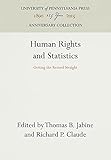Human Rights and Statistics : Getting the Record Straight / Thomas B. Jabine, Richard P. Claude.
Material type: TextSeries: Pennsylvania Studies in Human RightsPublisher: Philadelphia : University of Pennsylvania Press, [2016]Copyright date: ©1992Edition: Reprint 2016Description: 1 online resource (462 p.) : 57 illusContent type:
TextSeries: Pennsylvania Studies in Human RightsPublisher: Philadelphia : University of Pennsylvania Press, [2016]Copyright date: ©1992Edition: Reprint 2016Description: 1 online resource (462 p.) : 57 illusContent type: - 9780812231083
- 9781512802863
- online - DeGruyter
| Item type | Current library | Call number | URL | Status | Notes | Barcode | |
|---|---|---|---|---|---|---|---|
 eBook
eBook
|
Biblioteca "Angelicum" Pont. Univ. S.Tommaso d'Aquino Nuvola online | online - DeGruyter (Browse shelf(Opens below)) | Online access | Not for loan (Accesso limitato) | Accesso per gli utenti autorizzati / Access for authorized users | (dgr)9781512802863 |
Frontmatter -- Contents -- Preface -- Acknowledgments -- INTRODUCTION -- Chapter 1. Exploring Human Rights Issues with Statistics -- Chapter 2. The Limitations of Using Quantitative Data in Studying Human Rights Abuses -- Chapter 3. Use of Incomplete and Distorted Data in Inference About Human Rights Violations -- INTRODUCTION -- Chapter 4. Guidelines for Field Reporting of Basic Human Rights Violations -- Chapter 5. HURIDOCS Standard Formats as a Tool in the Documentation of Human Rights Violations -- Chapter 6. The Rights of Collectivities: Principles and Procedures in Measuring the Human Rights Status of Communal and Political Groups -- Chapter 7. Political Rights and Political Liberties in Nations: An Evaluation of Human Rights Measures, 1950 to 1984 -- Chapter 8. Problems of Concept and Measurement in the Study of Human Rights -- Chapter 9. Human Rights Reporting as a Policy Tool: An Examination of the State Department Country Reports -- Chapter 10. Human Rights Reporting in Two Nations: A Comparison of the United States and Norway -- INTRODUCTION -- Chapter 11. Statistical Evidence of Racial Disparities in Death Sentencing: A Critical Analysis of McCleskey ν. Kemp -- Chapter 12. A Statistical Analysis of Dutch Human Rights Case Law -- Chapter 13. An Epidemiology of Homicide: Ningún Nombre Burials in the Province of Buenos Aires from 1970 to 1984 -- Chapter 14. New Patterns of Oppression: An Updated Analysis of Human Rights Data -- Chapter 15. A Guide to Human Rights Data Sources -- Contributors -- Index -- Backmatter
restricted access online access with authorization star
http://purl.org/coar/access_right/c_16ec
Effective human rights advocacy and research require the use of statistics, carefully collected and objectively analyzed and presented, using the best techniques available. Statistics that lack credibility are of little value. Those that can be defended against critics can be effective in throwing the light on violations and promoting the observance of human rights for all. The contributors to this book, including experts in political science, public health, law, forensic pathology, and statistics, illustrate good statistical practice in the field of human rights and show the importance of collaboration between statisticians and other professionals. The treatment is largely nonmathematical, and the examples provide broad coverage of all features of the collection and use of statistical data on human rights violations. For readers who would like to do their own analyses, an extensive guide to human rights data sources is included. This book is the first to describe and summarize important issues associated with the collection and uses of human rights statistics.
Mode of access: Internet via World Wide Web.
In English.
Description based on online resource; title from PDF title page (publisher's Web site, viewed 23. Jul 2020)


